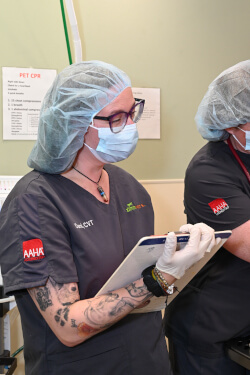Veterinary Surgical Services for Zimmerman MN Pets

ZimmVet offers high-quality surgical services to our clients. At our facility, we have the capability to perform a wide range of procedures, including spays, neuters, mass removals, laceration repairs, histopathology (tissue analysis is sent out), puppy tail docking and dewclaw removal, and ear hematoma repairs (ruptured vessel). We also offer in-house orthopedic surgeries by a board-certified surgeon and orthopedic surgeon consults.
We recommend spaying or neutering your pet at 6 months of age. Your pet will generally have a better temperament and fewer health problems if this is done at an early age. Studies show that 25% of intact female dogs will develop mammary cancer by the time they are adults. This risk dramatically decreases to less than 1% when females are spayed before their first heat. Younger pets are also usually healthier and recover faster from the surgery. Prior to surgery, we will perform a full physical exam of the animal, which includes blood work to ensure your pet is healthy enough for surgery.
ZimmVet now offers pre-surgical ECG (electrocardiogram). This is a painless procedure where a technician applies a few soft clamps to your pet’s skin to get a ECG reading. The ECG records the electrical signal from your pet’s heart to check for different heart conditions. The ECG is then submitted to a veterinary cardiologist for interpretation. The report gives ZimmVet veterinarians information to help make your pet’s anesthesia for surgery as safe as possible. If heart disease is detected additional testing may be recommended.
What to Expect on the Day of Surgery
At ZimmVet, we provide a high level of safety and care before, during, and after your pet’s surgical procedure. Prior to surgery, your animal companion will receive pain medication, which has been proven to reduce pain and discomfort experienced by the patient during and after surgery.
An intravenous catheter will be placed that permits the safe injection of anesthetic drugs. The catheter also gives the surgical team a direct port in case life-saving drugs need to be administered. To ensure adequate breathing during the procedure, a tracheal tube is used. Your canine or feline friend will receive fluids during the surgery to ensure proper blood pressure and hydration. A certified veterinary technician will closely monitor your pet during the surgery. The technician uses monitoring devices that measure blood pressure, heart rate, ECG, and oxygen saturation.
Your animal family member will be kept warm by a special warming blanket that eliminates the chance of a thermal skin burn. All of our equipment is routinely checked and calibrated to ensure safety during your pet’s surgery. Once in recovery, your animal friend is kept comfortable with blankets and pillows. The technicians administer pain medication, food, water, and take patients on bathroom breaks as soon as they are able. Your pet’s safety during surgery is our top priority.

Cryotherapy
Benefits of Cryotherapy
Cryotherapy is a treatment that has been around for years in both the human medical field as well as veterinary care to treat masses, skin lesions, skin tags, eye tumors and more. In recent times, the technology has become more precise and easier to use in the veterinary industry.
What is Cryotherapy
Cryotherapy is a procedure that uses extreme cold to destroy tissue. The process is called cryo-necrosis, or tissue destruction by freezing. Cryotherapy freezing is set to -80 degrees Fahrenheit to destroy the cells. Nitrous oxide is the active ingredient used in cryotherapy, instead of liquid nitrogen, which is what most people are familiar with. Liquid nitrogen is not used because the temperature achieved is lower than nitrous oxide and results are not as precise. Modern cryotherapy tools with nitrous oxide look like a large pen and can apply the cooling effect very precisely.
Anesthesia-Free
One of the biggest benefits of cryotherapy is that it can be used to remove small masses without the use of anesthesia or cutting of the skin. The cold temperatures apply a local numbing effect, which allows the pet to be treated with minimal discomfort. cryotherapy can be used to treat a wide range of benign skin lesions on pets such as adenomas, skin tags, and eyelid tumors. Another benefit is the cost of treatment is significantly lower as compared to surgical removal with anesthesia.
Side Effects
Potential for side effects are minimal, but a pet may lose pigment in the area causing a dark-colored pet to have a light spot. If all of the cells are not completely killed, the mass could grow back requiring additional treatments. With any defect in the skin, there is the potential for secondary skin infection.
Is Cryotherapy for my Pet?
It is not recommended to use cryotherapy on known or potentially cancerous masses. Your veterinarian will want to surgically remove the entire mass, so the cells can be looked at by a pathologist. The first step would be to make an appointment at ZimmVet to have your pet's masses examined by a doctor to determine the best course of action.


